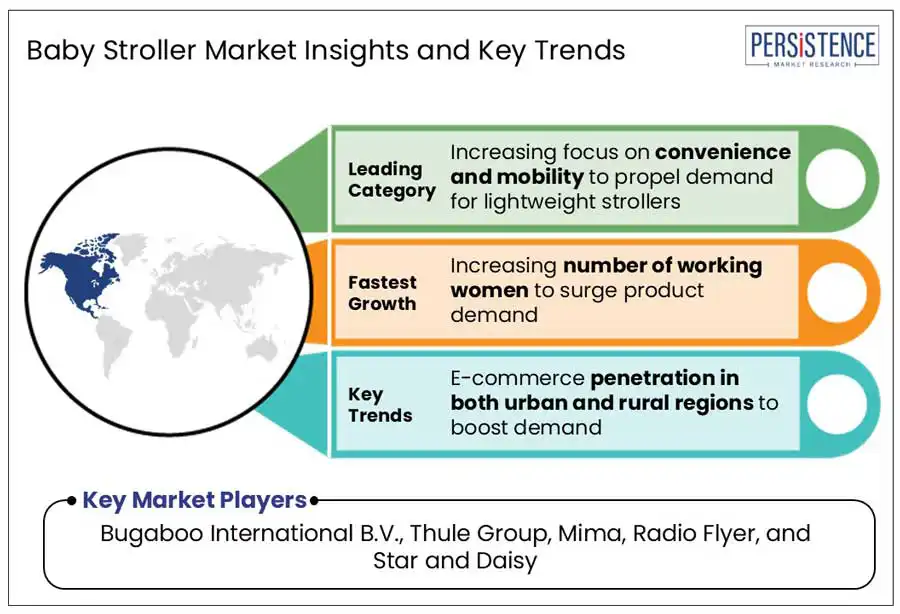Comprehensive Snapshot for Baby Strollers Market Including Regional and Country Analysis in Brief.
Industry: Consumer Goods
Published Date: April-2025
Format: PPT*, PDF, EXCEL
Delivery Timelines: Contact Sales
Number of Pages: 185
Report ID: PMRREP35206
The global baby stroller market size is projected to be valued at US$ 2712.9 Mn in 2025 and register a CAGR of 5.6% by 2032. The market is expected to hit US$ 3972.6 Mn by 2032.
Evolving family structure, growing shift towards urban living, and a booming e-Commerce industry is driving the demand for convenient, safe, and comfortable baby strollers globally. Companies such as Doona, Bugaboo, FirstCry, and others have introduced innovative products and are actively reshaping their strategies to maintain a stronghold in a competitive market. They are doing so by entering new geographies and launching limited-edition collaborations to enhance digital visibility and personalized product offerings.
According to the Persistence Market Research report the market is poised for a steady growth through 2032. Brands that prioritize innovation, regional adaptability, and accessibility are anticipated to be well-positioned and strengthen their position.

Key Industry Highlights
|
Global Market Attribute |
Key Insights |
|
Baby Stroller Market Size (2025E) |
US$ 2712.9 Mn |
|
Market Value Forecast (2032F) |
US$ 3972.6 Mn |
|
Projected Growth (CAGR 2025 to 2032) |
5.6% |
|
Historical Market Growth (CAGR 2019 to 2024) |
4.2% |
Increasing participation of women in the workforce is directly influencing the demand for baby strollers. Working women are preferring practical, time-saving, and mobility-enhancing childcare solutions that help to balance their professional and parenting responsibilities. These strollers make efficient transport medium for managing daily routines such as commuting, running errands, or travelling with their child.
As more women enter the workforce, the demand for baby products such as strollers that support independent caregiving is anticipated to witness considerable traction. For instance, as per World Bank Gender Data Portal, as of 2023, globally about 1.4 billion women were employed constituting around 40% of the total workforce across the globe.
In emerging markets including countries such as Indonesia, Vietnam, Kenya, Nigeria, Colombia, and others, traditional baby transport methods are still given precedence. This is due to the cultural norms and economic factors that people still prefer carrying infants in arms or cloth slings. The reliance on conventional practices, generally in such countries contribute to limited awareness and adoption of modern baby strollers. Such things are expected to inhibit the growth of the market to a certain extent during the forecast period. Addressing these issues through education, targeted marketing, and leveraging e-commerce platforms can help in increasing awareness and acceptance of baby strollers across these regions.
Rapid expansion of e-commerce sector and increasing digital penetration have helped to bridge the gap for consumers in both urban and rural regions. As per Statista, e-Commerce accounted for 20.1% of global retail sales in 2024. Online retail platforms such as Amazon, Flipkart, Lazada, and Shopee allow customers to browse, compare, and purchase strollers from a wide variety of brands without being limited by local store availability. This shift is particularly impactful in emerging economies, where physical retail infrastructure is limited, but mobile and internet usage is rising. With the growing reliance on digital platforms for product research, reviews, and comparison, even first-time parents in Tier 2 and Tier 3 cities are now empowered to make informed purchasing decisions.
FirstCry, one of India’s largest online baby product retailers, is a classic example of businesses leveraging e-Commerce. The company has successfully established its presence in semi-urban and rural regions. Moreover, it offers a wide selection of affordable to premium strollers, free home delivery, and cash-on-delivery options. As per studies, FirstCry’s Q3 FY25 (October-December 2024) revenue was reported to be US$ 254.12 Mn, a 14.3% increase from US$ 222.30 Mn in the previous year. Therefore, the booming online market and rising digital penetration is expected to create new growth opportunities for the companies in the forthcoming years.
On the basis of product, the lightweight segment is projected to hold a share of about 41% in 2025, driven by the growing trend of modern parenting lifestyles that prioritize convenience, mobility, and compact living. With more families living in urban settings, there is a high demand for lightweight strollers, designed to be foldable, portable, and often can be operated single-handedly.
On the other hand, travel system segment is projected to witness fast-growth during the forecast period. Travel systems, which integrate infant car seats with strollers, offer seamless transitions between vehicles and strolling. This multi-functionality appeals to modern parents seeking efficient solutions for on-the-go lifestyles.
Based on distribution channel, the offline segment is expected to register a share of about 57% in 2025. Offline stores comprising of specialty retailers offer enhanced shopping experiences by providing expert advice and personalized service. Further, the extensive product range in these stores allows parents to compare and choose the best option on the basis to their needs. Specialty retailers often stock premium brands and the latest models, attracting consumers who prioritize quality and innovation, thereby, driving the growth of the segment.
Online segment, on the other hand, is anticipated to be the fastest growing segment in the forthcoming years. The convenience of shopping from the comfort of home, coupled with ability to compare wide list of products and prices, is forecasted to boost the segmental growth through 2032.

North America is projected to account for a dominating share of 38% in 2025. High spending capacity of consumers, particularly in the U.S. and Canada is driving the demand for premium and multifunctional baby products. Besides, with a large proportion of working parents, the demand for convenient, compact, and travel-friendly strollers is anticipated to favor market growth. For instance, as per Bureau of Labor Statistics, 67% of families have both working parents in the U.S.
U.S. is likely to witness fast-growth during the forecast period. The presence of established players such as Evenflo, UPPAbaby, and BOB Gear is expected to favor market growth in the country. These companies are focusing on product innovation strategies to develop functional and high-end strollers. Besides, strong online presence of these brands is projected to boost the demand for the product in the forthcoming years.
Europe is likely to experience steady market between 2025 and 2032, driven by increasing demand for premium, long-lasting, and multifunctional strollers in countries such as France, Germany, and the U.K. In addition, stringent regulations by the European Union regarding child safety and well-being are propelling manufacturers to introduce products that meet highest safety and chemical compliance standards. For example, the EN 1888 Standard emphasizes on safety requirements and test methods for pushchairs and prams. These products are designed to carry children up to 15 kg each, with an additional 20 kg allowance for integrated platforms where a child can stand.
Asia Pacific is anticipated to experience substantial growth, driven by growing number of newborns in countries such as China, India, and Japan. According to a recent UNICEF report, South Asia countries such as India, Bhutan, Sri Lanka, and Nepal experience a significant rise in birth registration rates, rising from 39% in 2008 to 76% in 2024. The increasing digital influence and millennial parenting trends is propelling brands to capitalize by launching direct-to-consumer models, and engaging in digital campaigns.
China is experiencing considerable growth fueled by supportive government initiatives to boost child birth in the country. For example, the abolition of one-child policy now allows families to have up to three children. This policy shift has created exciting growth opportunities for companies to cater to the growing demand for durable and multifunctional strollers.
The global baby stroller market is experiencing considerable growth on account of companies focusing on introducing innovative baby stroller products. Established players are adopting various growth strategies such as partnerships, collaborations, and merger and acquisition to gain a major chunk of revenue share in the market.
Moreover, the market is witnessing increasing competition due to the entry of new brands offering cost-effective and feature-rich strollers. These companies are targeting emerging economies such as India, Turkey, Vietnam, Brazil, and others to maintain a stronghold.
For example, Silver Cross, a U.K. based company, has expanded its footprints in countries such as South Korea, Hong Kong, Singapore, and Malaysia, emphasizing the importance of emerging markets. Companies are also focusing on digital marketing, e-commerce channels, and customer-centric product customization to gain visibility and expand their reach. This dynamic and evolving landscape continues to push brands toward rapid innovation and strategic differentiation.
|
Report Attribute |
Details |
|
Historical Data/Actuals |
2019 - 2024 |
|
Forecast Period |
2025 - 2032 |
|
Market Analysis |
Value: US$ Mn |
|
Geographical Coverage |
|
|
Segmental Coverage |
|
|
Competitive Analysis |
|
|
Report Highlights |
|
|
Customization and Pricing |
Available upon request |
By Product
By Distribution Channel
By End-user
By Category
By Region
To know more about delivery timeline for this report Contact Sales

The global market is projected to value at US$ 2712.9 Mn in 2025.
The market is driven a booming e-Commerce industry and growing demand for convenience and mobility in baby products.
The market is poised to witness a CAGR of 5.6% from 2025 to 2032.
The increasing number of working women and high infant birth rate in emerging economies are the key market opportunities.
Major players in the baby stroller industry include Bugaboo International B.V., Thule Group, Mima, Radio Flyer, and Star and Daisy.